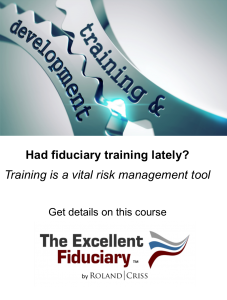Featured Insight
In recent years, employers sponsoring retirement plans under the Employee Retirement Income Security Act (ERISA) have increasingly turned to co-fiduciaries to shield themselves from ERISA fiduciary legal liability. Co-fiduciaries, often seen as a protective measure, have been employed to share the responsibilities and potential liabilities associated with managing retirement plans. However, lawsuits against employers for violating their fiduciary duty have exposed the limitations of relying on co-fiduciaries as a safeguard..

The Pitfalls of Relying on Co-fiduciaries
In recent years, employers sponsoring retirement plans under the Employee Retirement Income Security Act (“ERISA”) have increasingly turned to co-fiduciaries to shield themselves from ERISA fiduciary legal liability. Co-fiduciaries, often seen as a protective measure, have been employed to share the responsibilities and potential liabilities associated with managing retirement plans.
However, lawsuits against employers for violating their fiduciary duty have exposed the limitations of relying on co-fiduciaries as a safeguard.
The Illusion of Protection
While the concept of co-fiduciaries may initially appear to provide a layer of protection against fiduciary liability, recent legal cases have highlighted the potential pitfalls of this approach. Lawsuits targeting employers for breaches of fiduciary duties have brought to light the following key issues related to the reliance on co-fiduciaries:
- Shared Responsibility, Shared Liability: Employers may mistakenly believe that having co-fiduciaries will spread the burden of fiduciary duties and liabilities. However, legal actions have demonstrated that co-fiduciaries do not absolve employers of their ultimate responsibility for ensuring compliance with ERISA requirements.
- Inadequate Oversight: Co-fiduciaries can sometimes lead plan committees to a false sense of security and insufficient retirement plan oversight. This lack of oversight can leave employers vulnerable to legal challenges and liabilities arising from fiduciary breaches.
- Limited Risk Mitigation: Employers relying on co-fiduciaries as a risk mitigation strategy may find that this approach does not provide the anticipated level of protection. Legal precedents have shown that courts may still hold employers accountable for fiduciary breaches, regardless of co-fiduciaries’ involvement.
Navigating ERISA Fiduciary Responsibilities
In light of the evolving legal landscape and the potential limitations of co-fiduciaries, employers should proactively address their ERISA fiduciary responsibilities. To effectively manage fiduciary duties and minimize legal risks, employers can consider the following strategies:
- Comprehensive Due Diligence: Employers should conduct thorough due diligence when appointing co-fiduciaries, ensuring that these individuals or entities possess the expertise, resources, and commitment necessary to fulfill their fiduciary obligations effectively.
- Clear Documentation and Communication: Establishing clear documentation of the roles, responsibilities, and decision-making processes of co-fiduciaries is essential. Open communication and transparency regarding fiduciary activities can help mitigate potential misunderstandings and disputes.
- Regular Monitoring and Review: Employers should maintain active involvement in the oversight of retirement plans, regularly monitoring the actions and decisions of co-fiduciaries. This proactive approach can help identify and address potential compliance issues before they escalate into legal challenges.
- Legal Counsel and Compliance Guidance: Seeking legal counsel and compliance guidance from experienced professionals can provide employers with valuable insights into navigating ERISA fiduciary responsibilities effectively and mitigating legal liabilities.
The Best Way
The 4D Framework is a watershed model for employers that, instead of relying on vendors that use vague fiduciary titles as a risk mitigation strategy, addresses the crucial implications of processes and collaboration among stakeholders in EBP management.
It is a state-of-the-art governance, risk management, and compliance (“GRC”) strategy with workflows for employee benefit plan management. It enables conformance to ERISA fiduciary standards of care.





